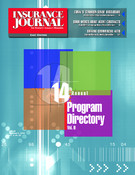According to conventional wisdom, 2004 was the first year in the past 16 where insurers finally broke through and made an underwriting profit on commercial lines auto. The breakthrough came after a year, 2003, which saw the countrywide combined ratio for commercial auto register 100.1 percent, which put insurers just at the breakeven point.
The improvement in 2004 was largely because all insurance rates went up after 9/11. Commercial auto rates have stabilized in recent years, after significant liability cost inflation during the 1990s, notes Dave Golden, director of commercial lines for the Property Casualty Insurers Association of America.
In spite of the turnaround, the competition has not become cutthroat, as can happen sometimes following a profitable period.
“Over the past two years we have seen a softening in the commercial auto market, but it’s not like it has suddenly cratered,” said Todd Reiser, president of transportation practice group, for Lockton Companies, a Kansas City, Mo.-based broker. “It’s a healthy competition.”
While the competition is under control, Eric Galisdorfer, assistant vice president, commercial auto for Peoria, Ill.-based RLI Corp., which got into the commercial auto business last year, expects that in 2005 and 2006 line of business profits will probably decrease again.
Lockton’s Reiser notes that commercial auto account desirability and pricing can depend on where the vehicles are. “If a fleet does most of its business in the Northeast, it’s definitely more difficult to underwrite than a Kansas City firm with a 500-mile shipping radius,” he said. “Even for a dedicated short-haul operation, it makes a huge difference whether they’re located in Kansas City or New York City.”
The term “commercial auto” is a catch-all category that includes everything from long- and short-haul trucking, hazardous material transport, delivery van fleets ranging from mom-and-pop businesses to UPS and FedEx, taxi and livery businesses that similarly range from small to large, according to Brian Sullivan, publisher of Risk Information Inc., a Dana Point, Calif.-based analyst of the property and casualty industry.
Sullivan, who compiles an annual listing of commercial auto insurance results, in his July 2005 analysis called 2004’s results “more impressive than we would ever have imagined.” Commercial auto liability earned premium rose 7.1 percent from the previous year, loss ratios fell from 61.3 percent to 55.8 percent, and physical damage loss ratios came in at 47.2 percent. Combined loss ratios of both liability and physical damage were 53.6 percent, from a high of 77.9 percent in 2000.
Ever since 9/11, trucking firms have been more focused on security, a trend that also helps the industry’s loss control efforts. Heightened security, increased scrutiny of hazardous material haulers, more stringent hiring qualifications and better driver safety programs have all lowered losses, points out Lockton’s Reiser.
Driver shortage
While there is a renewed emphasis on training, the industry is in the midst of a driver shortage, which can pressure smaller and less financially stable trucking firms into making bad hiring decisions. “Getting the right guy in the driver’s seat is the key to mitigation loss,” Reiser said.
Big truckers are also using a combination of sophisticated training and technology to mitigate loss. Simulators, “skid pads” (devices that train truck drivers to handle a rig in a skid situation), online recorders, satellite link tracking devices and newer collision and tipover warning systems are all improving safety for truckers.
Global positioning devices, in common use by large commercial fleets, combine not only accident data but also real-time engine management information, Golden said.
These and other safety devices are even trickling down to smaller commercial fleets, notes Golden of PCI. One of the simplest-seatbelt use-is being promoted by a partnership between PCI and the Federal Motor Carrier Safety Administration, which found that only 48 percent of truckers use them.
These safety methods have helped decrease the number of accidents per million of truck miles. Even though there are more cars and trucks on the road than 10 years ago, the U.S. Department of Transportation’s raw numbers show a declining accident rate.
Although the commercial auto market has posted significant improvements in the last several years, the industry is holding its breath on the reinsurance treaty renewals coming up on Jan. 1, 2006, and wondering whether the huge hurricane property losses will leak into other lines of business, said Galisdorfer of RLI.
Reiser of Lockton predicts that any insurers buying a lot of insurance in any line of business will see their costs rise. But the commercial auto market will be less affected than other lines, Galisdorfer said. “We’re still seeking unique opportunities where prices support our underwriting decisions,” he added.
Topics Auto Profit Loss Commercial Lines Tech Business Insurance Trucking
Was this article valuable?
Here are more articles you may enjoy.


 Four in New Jersey Face Charges in Alleged $250K Travel Insurance Scam
Four in New Jersey Face Charges in Alleged $250K Travel Insurance Scam  Longtime Motel 6 Spokesman Tom Bodett Settles Lawsuit Against Chain
Longtime Motel 6 Spokesman Tom Bodett Settles Lawsuit Against Chain  Howden US Tells Judge Brown & Brown Employees Fled Due to ‘Mistreatment’
Howden US Tells Judge Brown & Brown Employees Fled Due to ‘Mistreatment’  Kansas Man Sentenced to Probation for Insurance Fraud
Kansas Man Sentenced to Probation for Insurance Fraud 


